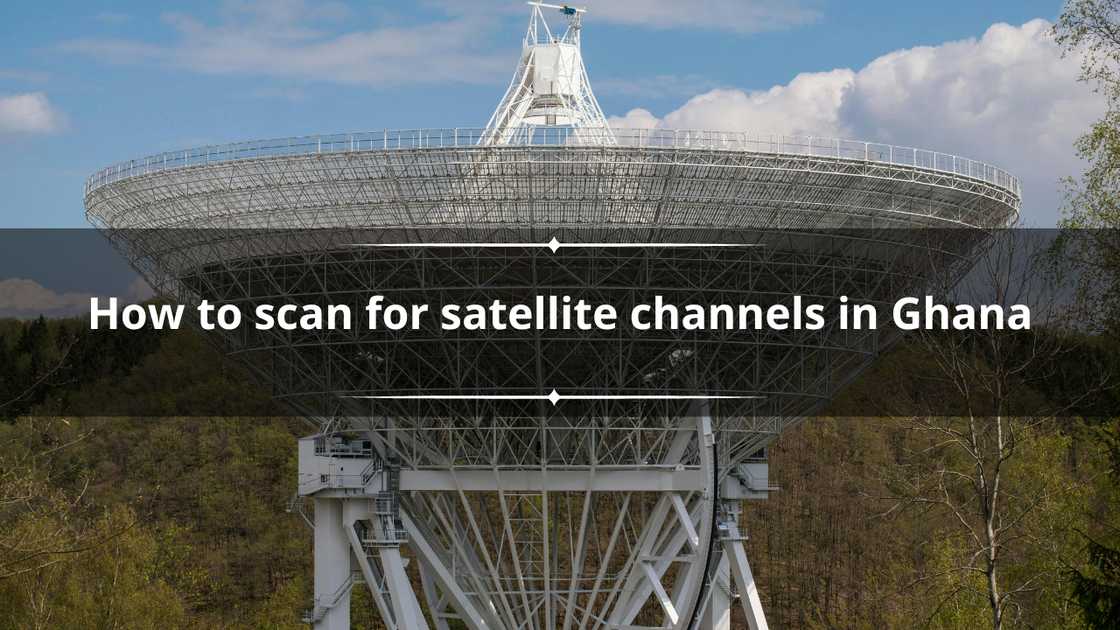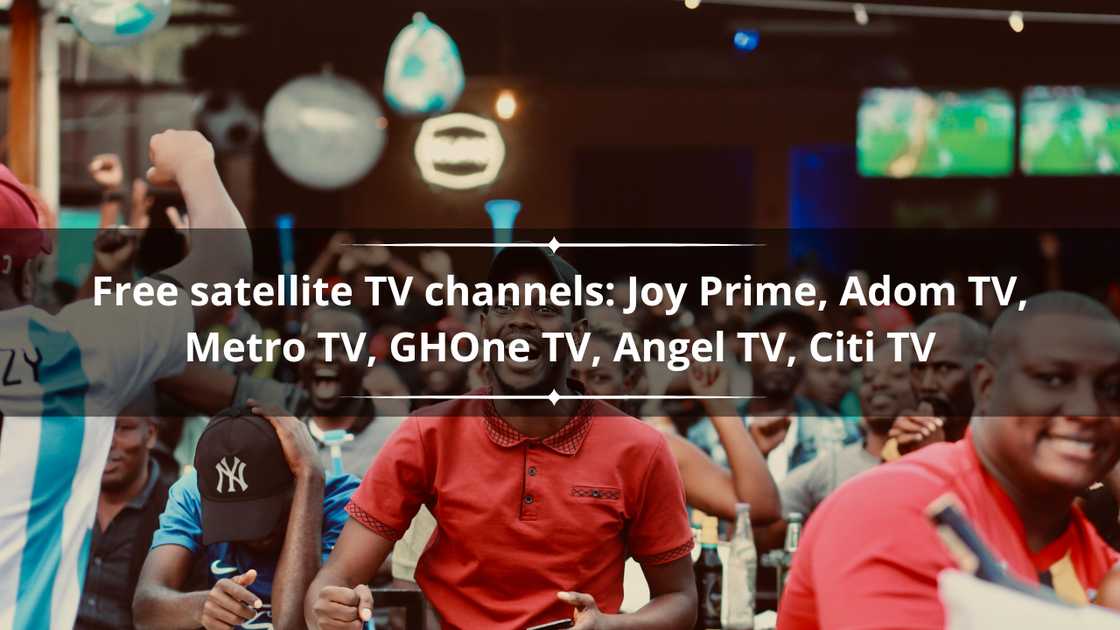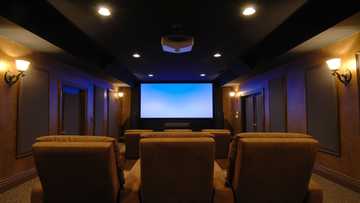Complete Guide to Satellite Frequencies in Ghana: Channels, Providers, and Updates
Satellite frequencies in Ghana have enabled TV stations to reach viewers in the hinterlands and across the continent. Ghanaians do not have to worry about missing their favourite channels or news just because they are outside the country. Below are some satellite frequencies and their dish you need to watch out for.

Source: Facebook
TABLE OF CONTENTS
- Key takeaways
- Satellite television
- List of satellite frequencies in Ghana
- Free satellite TV channels in Ghana
- Which satellite is used in Ghana?
- Which satellite has more channels in Ghana?
- Which satellite has the most free-to-air channels?
- How many satellite frequencies are in Ghana?
- What is the frequency of Max TV in Ghana?
- What is the frequency of Ghana TV?
- What is the frequency of a 16A satellite?
Key takeaways
- The top satellite frequencies in Ghana are Astra 2F, SES 5, Eutelsat 16A, and NigComSat-1R.
- These frequencies provide both free and pay-to-view channels.
- Ghana has over 99 free-to-air channels available.
Satellite television
Satellite television delivers TV programs by sending signals from a satellite in space to a viewer’s location. The satellite moves with Earth’s rotation. This allows satellite dishes to stay fixed in one direction to capture signals efficiently.
The dishes are parabolic and have an LNB that catches signals. These are sent to decoders—either external boxes or built-in TV tuners. The decoders process the signals so the viewer can watch the intended programs.
How to scan for satellite channels in Ghana
To enjoy smooth TV viewing, it is important to know satellite frequency, position, polarization, and symbol rates. Satellite names may be listed, but they're not crucial. These settings help your dish connect to the correct satellite signal easily.

Source: UGC
Polarization uses letters for direction: E (East), W (West), V (Vertical), and H (Horizontal). If you see "E," point your dish East. "H" or "V" tells you how to align the LNB—horizontally or vertically, depending on the signal.
Follow the steps below to scan for channels depending on the satellite system you're using (such as Free-to-Air, DSTV, or other satellite providers):
- Make sure the satellite dish is properly installed and aligned to the correct satellite.
- Connect your satellite receiver to the dish and TV.
- Access the receiver’s menu using the remote control.
- Go to Satellite Setup or Installation in the settings.
- Select Channel Scan or Automatic Scan to search for channels.
- Wait for the scan to finish and save the channels.
- Check the signal strength if channels are not found.
- Use a 1 to 3 meter dish for good reception in Ghana.
- Manually add or remove channels if needed.
Find your favorite free digital TV manual tuning frequency in Ghana below and enjoy a variety of channels both local and international.
List of satellite frequencies in Ghana
The satellites below offer free-to-air channels, including sports, news, and entertainment. Depending on the region, dish size requirements may vary. Explore the options for your viewing needs. Here is a list of satellite frequencies in Ghana 2025.
SES 5 @ 5.0° East (Multi TV)
Multi TV frequency in Ghana broadcasts popular free-to-air channels. You can also watch Joy Prime and Adom TV. A dish size of 60-90 cm is enough and the signal is strong and stable. It is a favourite for sports and local content.
Here are some channels under the Multi TV frequencies:
- 12525 MHz, Vertical, 30000 Ksps: Joy Prime, Adom TV, UTV, Cine Afrik
- 11900 MHz, Horizontal, 27500 Ksps: GHOne TV, Metro TV
- 12606 MHz, Horizontal, 30000 Ksps: Sports and movie channels
- 12645 MHz, Vertical, 30000 Ksps: Free-to-Air regional and gospel channels
Eutelsat 16A @ 16.0° East

Source: UGC
This satellite offers a variety of free-to-air channels. In Ghana, you can watch TV3 Ghana and Citi TV. The satellite also features gospel and entertainment content. A dish between 90 cm and 1.2 meters is ideal. It’s great for both English and French viewers.
- 12522 MHz, Horizontal, 30000 Ksps: TV3 Ghana, Citi TV, GTV, Angel TV
- 12722 MHz, Vertical, 26657 Ksps: Pan-African music, gospel, and regional content
- 10928 MHz, Vertical, 30000 Ksps: Entertainment channels in English and French
Nilesat @ 7.0° West
This satellite offers many free-to-air channels, including sports like beIN Sports. It’s a good alternative to DSTV. To access its signal, a large dish is needed. In the North, dishes range from one to three meters. In the south, anything under four meters may not work.
- 11938 MHz, Horizontal, 27500 Ksps: Al Jazeera, MBC, Nile Family, religious channels
- 12054 MHz, Vertical, 27500 Ksps: Arabic movies, news, music (useful for multicultural households)
- 11096 MHz, Horizontal, 27500 Ksps: Variety channels and international news
Eutelsat 7B @ 7.0° East
You will get lots of free international content here. It airs news, entertainment, and educational shows. You’ll also find faith-based programs. A dish size of 90 cm to 1.2 meters works well in Ghana. It’s a good pick for diverse viewers.
- 10721 MHz, Horizontal, 22000 Ksps: FTA channels including international news and general entertainment
- 11304 MHz, Vertical, 29700 Ksps: Free educational and faith-based content
Astra 2F/2E/2G @ 28.2° East
This is the Astra satellite frequency in Ghana today. It offers offers top UK free channels. You can get BBC One, ITV, and Channel 4. Sky News and Film4 are also available. The signal is weak in some parts of Ghana. A large dish, 1.8 meters or more, is often needed. Below is its satellite frequency list;
- 10714 MHz, Horizontal, 22000 Ksps: BBC One, ITV, Channel 4 (FTA, UK beam – signal weak in some parts of Ghana)
- 10773 MHz, Horizontal, 22000 Ksps: BBC News, BBC Parliament, E4, Film4
- 10847 MHz, Vertical, 23000 Ksps: Sky News, Horror Channel, CBS Reality
Badr 4 @ 26.0° East

Source: UGC
Badr 4 @ 26.0° East airs free Arabic music, news, and sports. A 90 cm to 1.2 m dish works in Ghana.
- 12149 MHz, Horizontal, 27500 Ksps: Middle Eastern content, sports, news
- 12073 MHz, Horizontal, 27500 Ksps: FTA music and Arabic programming
Intelsat 20 @ 68.5° East
Intelsat 20 @ 68.5° East features Zee, Sony, and Star TV. Most channels are encrypted, but some are free-to-air.
- 12562 MHz, Vertical, 27500 Ksps: Zee, Sony, Star TV (mostly encrypted, with some occasional FTA access)
Eutelsat 36B @ 36.0° East
If you were wondering which satellite DStv use in Ghana, this is it. Most channels are encrypted and require a subscription.
- 12245 MHz, Horizontal, 27500 Ksps: Used by DStv (mostly encrypted, requires subscription)
Amos 17 @ 17.0°E
This satellite offers African content and Christian programming. A 90 cm to 1.2 m dish is ideal.
- 11105 MHz, Vertical, 30000 Ksps: African content and Christian programming
NigComSat-1R @ 42.5°E
NigComSat-1R @ 42.5°E broadcasts Nigerian and West African content. A 90 cm to 1.2 m dish works well.
- 12518 MHz, Vertical, 27500 Ksps: Nigerian and regional West African FTA content
ABS-3A @ 3.0°W
ABS-3A @ 3.0°W offers gospel, family, and free-to-air channels. A 90 cm to 1.2 m dish is recommended.
- 11090 MHz, Vertical, 30000 Ksps – Gospel, family, and Free-to-Air channels
Free satellite TV channels in Ghana
Ghana has many free-to-air satellite TV channels. These channels cover news, entertainment, religion, and more. Viewers do not need to pay any subscription fees. A satellite dish and decoder are all that’s needed.

Source: UGC
Here is a list of free satellite TV channels available in Ghana.
- GTV (Ghana Television)
- TV3 Ghana
- UTV Ghana
- Joy Prime
- Adom TV
- Metro TV
- GHOne TV
- Angel TV
- Citi TV
- Homebase TV
- Net 2 TV
- EBN TV
- TV XYZ
- ATV Ghana
- Crystal TV
Which satellite is used in Ghana?
There are several satellites in Ghana, used for television broadcasting including; Intelsat 20, Eutelsat 7 West A and Nilesat 201.
Which satellite has more channels in Ghana?
Eutelsat satellites offer the most channels in Ghana. Most of these are free-to-air (FTA). You’ll find a wide variety, including exclusive and HD content. Other satellites like Astra 28.2°E also have channels, while Eutelsat is often preferred for its many FTA options.
Which satellite has the most free-to-air channels?
It's hard to name one satellite with the most free-to-air (FTA) channels in Ghana. However, Eutelsat and SES stand out. Eutelsat offers many FTA channels across Sub-Saharan Africa. SES also promotes FTA HD channels in Ghana.
How many satellite frequencies are in Ghana?
As of Q4 2023, Ghana's NCA has licensed 175 TV stations. Of these, 99 are Free-To-Air Satellite TV with single channels. There are 3 Pay TV Satellite TV stations and 8 Free-To-Air Satellite TV stations with bouquets.

Source: UGC
What is the frequency of Max TV in Ghana?
You can watch Max TV in Ghana on the Eutelsat 16A satellite. The frequency is 11595 MHz. It uses vertical polarization (V). The symbol rate is 30000. The FEC is 3/5.
What is the frequency of Ghana TV?
Ghana TV is available across several satellites with the main ones being;
- Express AMU1 (36.1°E): 12476 MHz, Horizontal, Symbol Rate: 30000
- Eutelsat 7B (7.0°E): 11785 MHz, Horizontal, Symbol Rate: 30000
You can watch it using a satellite dish and receiver that supports these frequencies. You can also access Ghana TV through digital TV in Ghana.
What is the frequency of a 16A satellite?
The Eutelsat 16A satellite works in the Ku-band. One of its main signals is at 11.63675 GHz. This is used to send TV and radio. It also uses other signals like 10.721 GHz and 10.762 GHz for some channels and services.
Satellite frequencies in Ghana have helped in spreading local channels to various countries across the globe. Ghanaians who may be living abroad or in remote areas can now follow the day-to-day activities in the country.
Yen.com.gh recently shared an article on Multi TV: Installation guide, TV decoder, channels, and frequencies. Multi TV is a direct-to-home satellite television station in Ghana that brings you non-stop entertainment throughout the day.
An advantage of using Multi TV is that it does not bother users with monthly charges. Setting up your home entertainment system just got easier with this Multi TV: Installation guide. It is designed to walk you through everything you need to know.
Source: YEN.com.gh

Chris Ndetei (Lifestyle writer) Christopher Ndetei is a writer who joined the Yen team in May 2021. He graduated from Machakos Technical College in 2009 with a Diploma in ICT and has over four years of experience in SEO writing. Christopher specialises in lifestyle and entertainment coverage, with a focus on biographies, life hacks, gaming, and guides. He has completed the AFP course on Digital Investigation Techniques (2023) and earned the Google News Initiative Certificate (2024). In recognition of his work, he was named Yen Writer of the Year in 2024. You can connect with him via email at chrisndetei@gmail.com.

Sharon Boit (Lifestyle writer) Sharon J. Boit is a creative writer and researcher with over 10 years of experience. She began her career as a project manager and researcher at the Center for Urban Research and Innovations, University of Nairobi. Sharon has written articles and blog posts for MSN News, Ihamba Adventures, and Industry Biz. She joined Yen.com.gh as a Lifestyle Writer in October 2024, covering entertainment, sports, education, and finance. You can reach Sharon J. Boit by email at boit@gmail.com.








